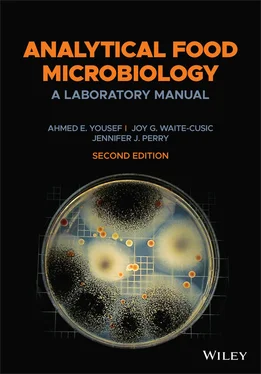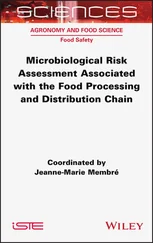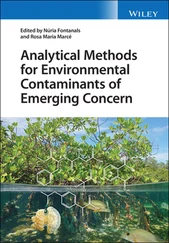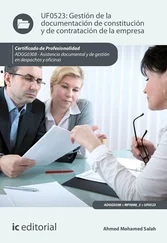3 Put the exercise summary (and the blank sheet) in the provided plastic sleeve; this is a sanitizable pocket for protection against spills. Present the exercise summary on the bench to be reviewed by the instructor.
4 Hair that is longer than shoulder length must be tied up.
5 Wash hands in the laboratory sink using the soap and disposable towels provided.
6 Put on a lab coat; when not in use, these should be stored in the laboratory throughout the course.
7 Put on disposable gloves and sanitize the bench; a quaternary ammonium solution or alcohol is often used for bench sanitization.
8 Listen carefully to the instructor’s short presentation; this presentation may include seating chart, assignment for the food to be analyzed, potential pitfalls, etc.
9 Start the exercise when instructed to do so.
While Executing the Exercise
1 Be aware of whether you are working individually or in groups of two or more. If working in groups, part of the work could be carried out individually and the other part is done cooperatively. If working in a group, make sure you communicate clearly with laboratory partner(s) before starting the exercise.
2 Start the laboratory exercise and observe the safety rules described earlier.
3 Do your best to complete the work efficiently and diligently.
4 Make sure you share the progress of the exercise or problems encountered with one of the instructors.
5 Record your observations or results. The exercise summary sheet or a separate sheet of paper may be used for recording. Alternatively, hand‐held electronic notepads may be provided by instructors for note taking and data collection.
Immediately After Completing the Laboratory Exercise
1 Show your work (mounted microscope slide, reaction results, colony counts, etc.) to the instructor.
2 If asked, transfer the data collected to the class computer or class data sheet.
3 Dispose of work items correctly.
4 Sanitize the bench using the sanitizer provided (often a quaternary ammonium sanitizer or alcohol).
5 Remove disposable gloves and place them in the biohazard container.
6 Store lab coat appropriately.
7 Wash hands.
8 Take your belongings and exit the laboratory.
1 Centers for Disease Control and Prevention. (2020). Biosafety in microbiological and biomedical laboratories. 6th ed. U.S. Department of Health and Human Services, Washington, DC, USA.
CHAPTER 2 SAMPLING FOR MICROBIOLOGICAL ANALYSIS OF FOOD AND PROCESSING ENVIRONMENT
It is a challenge to be able to assess the microbiological quality and safety of food accurately. The approach often used is a stepwise procedure that includes sampling, sample preparation, laboratory analysis, data collection, and result interpretation. Errors in each of these steps cumulatively determine the reliability of the overall procedure. Sampling can be an elaborate exercise ( Figure 2.1), and analysts consider it the most error‐prone step. Poorly planned and executed sampling operations compromise the analyst’s ability to assess the quality or safety of food. This chapter includes two main sections: “Theoretical aspects,” which provides the knowledge needed for proper sampling, and “Practicing sampling and sample preparation,” which is a simplified practical exercise.
This section covers the theoretical principles of sampling and sample‐size calculations. Additionally, techniques that may be followed during sampling and sample preparation of food or processing environment are covered.
Sampling Principles
Introduction
In the simplest sense, a “sample” may be defined as a small and manageable quantity intended to represent the whole. The whole is commonly referred to as the “population,” and in relevance to the subject matter of this book, the population is the food lot. Foods vary considerably in physical, chemical, and microbiological characteristics. These variations dictate the way a food is sampled and analyzed. Physically, food could be in a solid, gel, or liquid state, at different degrees of hydrophobicity, with ingredients in homogeneous or heterogeneous distribution. Compositionally, foods vary in water content, pH, presence of antimicrobial ingredients, and many other attributes. Foods differ in microbial burden and profile; this depends on whether the food is raw or processed, and the type of processing it received. The goal of the analysis also varies. Some foods are analyzed for the enumeration of indicator microorganisms (e.g., coliforms), whereas others are tested for the presence of pathogens (e.g., Listeria monocytogenes ). These factors must be taken into account to determine appropriate sampling, sample preparation, and microbial recovery methodology.
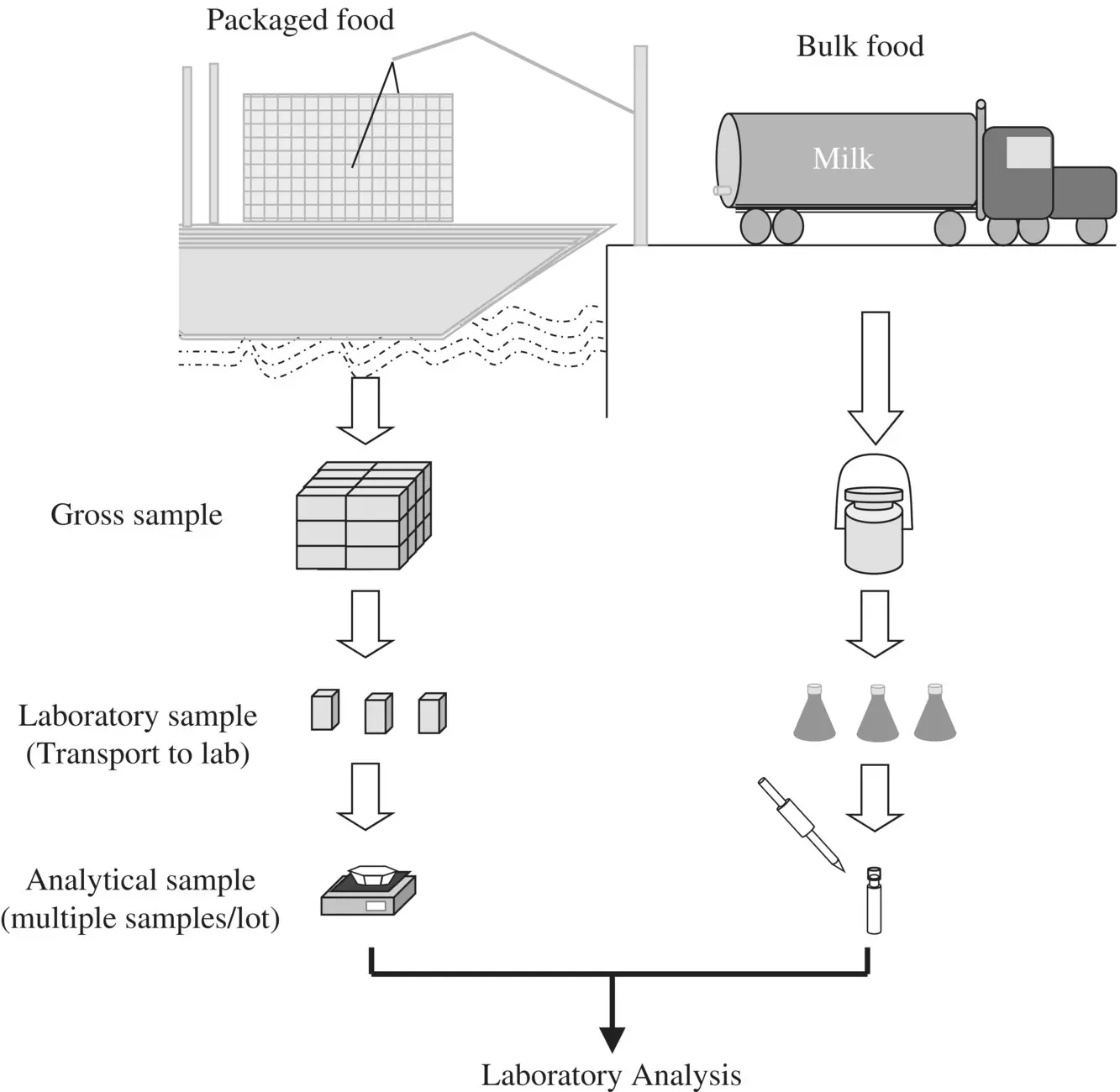
Figure 2.1 Food sampling.
Foods subject to analysis are usually found in sizable quantities located in a storage facility, ship container, tanker, retail display case, vendor stand in open market, etc. With consideration of the size of the food lot and expected variations among multiple samples from the same lot, a number of samples are collected for analysis on the hope that they accurately represent the entire lot. If samples taken are not a good representation of the whole, whether it is the fault of the sample collector or due to an error inherent in the sampling plan, the laboratory results will be misleading. Therefore, sampling operations should be planned well. Additionally, every effort should be made to avoid mishandling or contamination of the collected sample. Correctly withdrawn, handled, and analyzed samples may serve as evidence of the quality or the safety of the whole.
Although food is emphasized in this book, sampling and analysis of water and processing environment will also be addressed. A sample of water from a stream is described as a “specimen.” Similarly, samples from circulating cleaning or rinsing solution or swabs from a moving conveyer belt are also considered specimens. In these situations, the population sampled is not static and thus getting a representative portion is a challenging task.
Preparing A Sampling Plan
Sampling is an essential step in any procedure for assessing the microbiological quality or safety of food. Sampling is an integral part of food inspection, which is practiced for commercial or legal reasons. Researchers experimenting with food need sampling schemes that lead to statistically meaningful results. Regardless of the ultimate goal of the analysis, sampling should be planned and executed properly. The following are steps used in preparing a sound sampling plan.
1 Identify the Reasons for SamplingSampling is a key and critical step in microbiological analyses that are done for many reasons including: (i) assessing the general microbiological quality of a raw product or an ingredient; (ii) validating a food processing operation; (iii) assuring the safety of the processed food; and (iv) evaluating the sanitary condition of a food processing environment. Each of these cases require a carefully considered sampling plan.
2 Assess the Size, Nature, and Uniformity of the Lot to be SampledThe population (i.e., the food lot) from which the samples are to be taken could be made of discrete units or bulk in a container. For example, a food lot of half‐and‐half coffee cream could be a stack of wholesale boxes, each containing multiple smaller retail boxes, and the latter containing multiple single‐serve (0.4 oz.) units. Alternatively, the lot could be bulk flour in a store bin or sack, milk in a tanker, or loose grains in a silo.Sampling starts by taking a number of units from the stacks of the lot or a portion of the bulk; these are described as gross (or primary) samples ( Figure 2.1). Subsets of gross samples constitute the laboratory samples. The analyst who receives laboratory samples should further reduce them to test samples. For example, a laboratory sample could be a 10 lb cheese block, from which a 25 g test sample is withdrawn. In this particular example, it is desirable to collect several test samples to overcome the lack of uniformity from the edge to the center of the cheese block. Once the test sample is subjected to laboratory analysis, it is no longer described as a “sample.” Instead, the analyst should use descriptive words such as food homogenate, test solution, cell suspension, cell pellet, culture supernatant, isolate, etc. Note that the number of samples to be withdrawn from the lot is determined as described later.
Читать дальше
